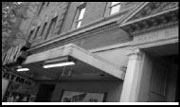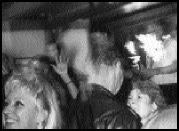For decades, the corner of First and Pike has been defined by tidy three- and five-story buildings, cobblestone streets, and the celebrated Pike Place Market clock. Market-area residents have fought fiercely against encroachment from the hotel barons and condo developers who remade Belltown into a terra cotta-tinted yuppie enclave. They’re fighting again now, with low-income-housing activists, and perhaps the city, on their side.
The building, known as both the Hahn Building and the Elliott Hotel, has been owned since 1987 by a developer named Douglas Buck. (Buck did not return calls for comment.) For years, the building served as single-room occupancy (SRO) housing for around 35 low-income tenants; a loan agreement with the city mandated that the building be preserved as low-income housing until the loan was paid off in December 2003. But around April of last year, tenants began moving out. “Somewhat surreptitiously, everybody was given the heave-ho and the building was emptied,” says Joe Martin, a longtime housing activist who works at Pike Place Market. Plans for a 12-story mixed-use development were filed with the city in 2001; drawings on file there show a bland, outsized beige-colored tower, with the sort of glassed-in upper-level residential balconies that have become ubiquitous in the downtown core.
But the Hahn faces a major obstacle on its way to becoming yet another casualty of downtown yuppification: Its loan agreement, which restricts rooms in the building to people making less than 50 percent of the Seattle median income, was never changed to allow the new development. To advocates like John McLaren, an architect and Seattle Displacement Coalition member, it looks like an open-and-shut case. “In terms of the letter of the agreement, which says the owner shall keep this building affordable to low-income tenants, the owner seems to be in violation,” McLaren says.
So why hasn’t the agreement been enforced? Partly, the problem is inertia; housing advocates didn’t get wind of the changes at First and Pike until this spring, and by then, all the Hahn’s former tenants had long since packed up and left the premises. Partly, it’s that the city often doesn’t follow up on such cases unless they’re brought to its attention. About a week ago, city housing office director Cynthia Parker says, the housing office sent notice that Buck’s company, Marketview Place Associates, was “in default under the terms of the agreement—the loan itself requires them to provide housing for low-income occupants.” If they choose not to do so, the company could be liable for the remaining $230,000 balance on the loan.
But the short-term solution won’t solve the larger problems at the corner. Buildings like the Hahn once served as short-term housing for dock workers and seamen who came to Seattle in the early 20th century. According to Janet Mackenzie from the city’s housing office, SROs continued to serve a valuable purpose throughout the century: They were “a totally legitimate and adequate way” of housing people who were often just one Social Security check away from homelessness. “The sort of housing the Hahn building represents was the housing of choice for a lot of people for many decades because of the simplicity” of living in a single room, Martin says. But the market for SROs shrank dramatically in the late 20th century, when a trend toward traditional apartment housing and a booming real estate market conspired to wipe them off the downtown grid. In 1980, according to the city’s figures, there were about 4,150 occupied SROs; by 2001, that figure had dropped to fewer than 2,000.
Martin is concerned about the impact of yet another multistory, vanilla monolith. “For many people, having a big 12-story building right outside Pike Place Market would be architecturally unpalatable,” Martin says. “This is not any other intersection in the city. This is First and Pike.”








